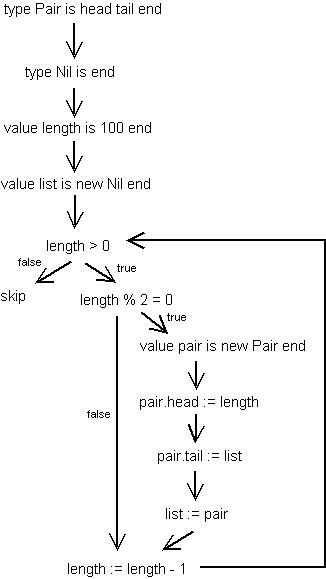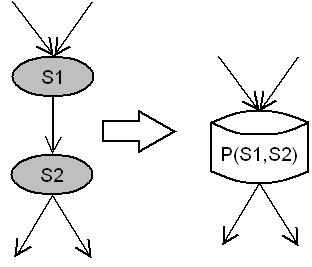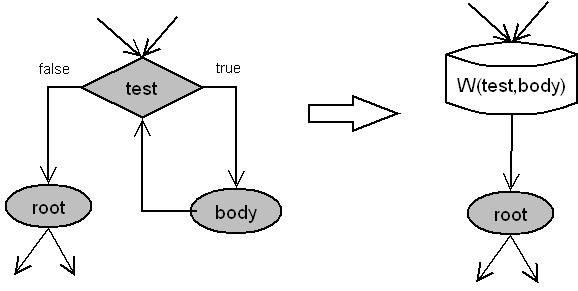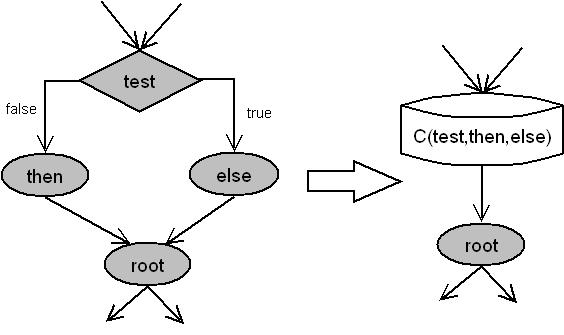A Command Language
Contents
- Overview
- XCom - A Simple Command Language
- An Evaluator for XCom
- A Translator for XCom with Dynamic Types
- A Translator for XCom with Static Types
- Compiling XCom
- Flow Graphs
Overview
When modelling applications there is often a requirement for some kind of command language. UML, for example, has state machines where the actions on the transitions are written in an action language and describe what happens to the state of the system when the transitions are fired. One way of providing support for actions in a model is to allow the user to write commands in their favourite programming language; the commands are represented in the model as strings. This is a very weak form of command language, since the strings cannot be processed easily by the modelling engines. Typically they cannot be performed at all until the models are exported as program code, where the command strings are simply embedded in the output.More flexibility is provided by modelling the command language. The model instances can then be intereted by an engine as part of performing the overall model. Furthermore, since the commands are modelled, they can be analysed in various ways and transformed to different target implementation languages rather than being limited to one.
This chapter is concerned with writing interpreters (translators and compilers) for a command language. When defining an interpretive semantics for a language there is often a similar language at hand (at least the language in which the interpreter is written).There is a choice choice as to whether the syntax structures are directly interpreted or whether they are translated to syntax phrases in the existing language. The advantage of a translational approach is that the execution engine for the target language already exists and is probably more efficient than any interpreter we could write for the source language.
Compilers are translators for languages where the target language is usually highly optimized and very different from the source language. In principle, however, there is no essential difference between a transator and a compiler. A language that uses the translational approach to target a sub-language of itself is often referred to as desugaring the source language.
To top.
XCom - A Simple Command Language
XCom is a simple command language with values that are either records or are atomic. An atomic data value is a string, integer or boolean. A record is a collection of named values. XCom is block-structured where blocks contain type definitions and value definitions. XCom has simple control structures: conditional statements and loops. The following is a simple example XCom program that builds a list of even numbers from 2 to 100:begin
type Pair is head tail end
type Nil is end
value length is 100 end
value list is new Nil end
while length > 0 do
begin
if length % 2 = 0
then
begin
value pair is new Pair end
pair.head := length;
pair.tail := list;
list := pair;
end
end;
length := length - 1;
end
end
Operations are defined on values in the semantic domain that will be used by the execution mechanism, for example:
context Bool
@Operation binAnd(Bool(b))
Bool(value and b)
end
context Bool
@Operation binOr(Bool(b))
Bool(value or b)
end
context Int
@Operation binAdd(Int(n))
Int(value + n)
end
context Record
@Operation lookup(name:String)
fields->at(type.names->indexOf(name))
end
context Record
@Operation update(name:String,value:Element)
fields->setAt(type.names->indexOf(name),value)
end
The concrete syntax of expressions is defined by the XBNF grammar for the class Exp:
@Grammar
// Start at Exp. Logical operators bind weakest.
Exp ::=
e = ArithExp
[ op = LogicalOp l = Exp { BinExp(op,e,l) } ].
LogicalOp ::=
'and' { "and" }
| 'or' { "or" }.
// The '.' for field ref binds tighter than '+' etc.
ArithExp ::=
e = FieldRef
[ op = ArithOp a = FieldRef { BinExp(op,e,a) } ].
ArithOp ::=
'+' { "+" }.
// A field reference '.' optionally follows an atomic expression.
FieldRef ::=
e = Atom
( '.' n = Name { FieldRef(e,n) }
| { e }
).
// Atomic expressions can be arbitrary exps if in ( and ).
Atom ::=
Const
| Var
| New
| '(' Exp ')'.
Const ::=
IntConst
| BoolConst.
IntConst ::=
i = Int
{ Const(i) }.
BoolConst ::=
'true' { Const(true) }
| 'false' { Const(false) }.
Var ::=
n = Name { Var(n) }.
New ::=
'new' n = Name { New(n) }.
end
- Introduce new names associated with either types or values.
- Control the flow of execution.
- Perform side effects on records.
@Grammar extends Exp.grammar
Statement ::=
Block
| Declaration
| While
| If
| Update
| FieldUpdate.
Block ::=
'begin'
s = Statement*
'end'
{ Block(s) }.
Declaration ::=
TypeDeclaration
| ValueDeclaration.
TypeDeclaration ::=
'type'
n = Name
'is' ns = Name*
'end'
{ TypeDeclaration(n,ns) }.
ValueDeclaration ::=
'value'
n = Name
'is' e = Exp
'end'
{ ValueDeclaration(n,e) }.
FieldUpdate ::=
e = Exp
'.' n = Name
':=' v = Exp ';'
{ FieldUpdate(e,n,v) }.
While ::=
'while'
e = Exp
'do' s = Statement
'end'
{ While(e,s) }.
If ::=
'if' e = Exp
'then' s1 = Statement
'else' s2 = Statement
'end'
{ If(e,s1,s2) }.
Update ::=
n = Name
':=' e = Exp ';'
{ Update(n,e) }.
end
An Evaluator for XCom
As described in the introducion we are interested in defining XCom operational semantics. We will do this in a number of different ways in the rest of this note. The first, and possibly most straightforward, approach is to define an interpreter for XCom in the XOCL language. This involves writing an eval operation for each of the XCom syntax classes. The eval operation must be parameterized with respect to any context information that is required to perform the evaluation. An XCom program p is then evaluated in a context e by: p.eval(e).To top.
Evaluating Expressions
Expression evaluation is defined by adding eval operations to each class. This section defines the eval operation:context Const
@Operation eval(env)
@TypeCase(value)
Boolean do Bool(value) end
Integer do Int(value) end
end
end
context Var
@Operation eval(env)
env.lookup(name)
end
context BinExp
@Operation eval(env)
@Case op of
"and" do left.eval(env).binAnd(right.eval(env)) end
"or" do left.eval(env).binOr(right.eval(env)) end
"+" do left.eval(env).binAdd(right.eval(env)) end
end
end
context New
@Operation eval(env)
env.lookup(type).new()
end
context FieldRef
@Operation eval(env)
value.eval(env).lookup(name)
end
Evaluating Statements
XCom statements are performed in order to introduce new names, control flow or to update a record field. Statements are defined to evaluate in a context and must observe the rules of scope that require variables are local to the block that introduces them. The context of execution is an environment; evaluation of a statement may update the supplied environment, so statement evaluation returns an environment:context ValueDeclaration
@Operation eval(env)
env.bind(name,value.eval(env))
end
context TypeDeclaration
@Operation eval(env)
env.bind(name,Type(names))
end
context Block
@Operation eval(originalEnv)
let env = originalEnv
in @For statement in statements do
env := statement.eval(env)
end
end;
originalEnv
end
context While
@Operation eval(originalEnv)
let env = orginalEnv
in @While test.eval(env).value do
env := body.eval(env)
end;
originalEnv
end
end
context If
@Operation eval(env)
if test.eval(env).value
then thenPart.eval(env)
else elsePart.eval(env)
end
end
context FieldUpdate
@Operation eval(env)
record.eval(env).update(name,value.eval(env))
end
context Update
@Operation eval(env)
env.update(name,value.eval(env))
end
A Translator for XCom with Dynamic Types
The previous section defines an interpreter for XCom. This is an appealing way to define the operational semantics of a language because the rules of evaluation work directly on the abstract syntax structures. However the resulting interpreter can often be very inefficient. Furthermore, an interpreter can lead to an evaluation phase distinction.Suppose that XCom is to be embedded in XOCL. XOCL has its own interpretive mechanism (the XMF VM); at the boundary between XOCL and XCom the XOCL interpretive mechanism must hand over to the XCom interpreter -- the XCom code that is performed is a data structure, a completely alien format to the VM. This phase distinction can lead to problems when using standard tools, such as save and load mechanisms, with respect to the new language. For example a mechanism that can save XOCL code to disk cannot be used to save XCom code to disk (it can, however, be used to save the XCom interpreter to disk).
An alternative strategy is to translate the source code of XCom to a language for which we have an efficient implementation. No new interpretive mechanism is required and no phase distinction arises. Translation provides the opportunity for static analysis (since translation is performed prior to executing the program). As we mentioned earlier, static analysis can translate out any type information from XCom programs; the resulting program does not require run-time types.
Since static analysis requires a little more work, this section describes a simple translation from XCom to XOCL that results in run-time types; the subsequent section showshow this can be extended to analyse types statically and remove them from the semantic domain.
To top.
Translating Expressions
Translation is defined by adding a new operation desugar} to each sbatract syntax class. There is no static analysis, so the operation does not require any arguments. The result of the operation is a value of type Performable which is the type of elements that can be executed by the XMF execution engine. An XCom constant is translated to an XOCL constant:context Const
@Operation desugar1():Performable
value.lift()
end
context BinExp
@Operation desugar1():Performable
@Case op of
"and" do [| <left.desugar1()> and <right.desugar1()> |] end
"or" do [| <left.desugar1()> and <right.desugar1()> |] end
"+" do [| <left.desugar1()> + <right.desugar1()> |] end
end
end
context New
@Operation desugar1():Performable
[| <OCL::Var(type)>.new() |]
end
context Var
@Operation desugar1():Performable
OCL::Var(name)
end
context FieldRef
@Operation desugar1():Performable
[| <value.desugar1()>.ref(<StrExp(name)>) |]
end
Translating Statements
An XCom statement can involve local blocks. The equivalent XOCL expression that provides local definitions is let. A let expression consists of a name, a value expression and a body expression. Thus, in order to translate an XCom declaration to an XOCL let we need to be passed the body of the let. This leads to a translational style for XCom commands called continuation passing where each desugar1 operation is supplied with the XOCL command that will be performed next.A type declaration is translated to a local definition for the type name. Note that the expression names.lift() translates the sequence of names to an expression that, when performed, produces the same sequence of names: list is a means of performing evaluation in reverse:
context TypeDeclaration
@Operation desugar1(next:Performable):Performable
[| let <name> = Type(<names.lift()>)
in <next>
end |]
end
context ValueDeclaration
@Operation desugar1(next:Performable):Performable
[| let <name> = <value.desugar1()>
in <next>
end |]
end
context Statements
@Operation desugar1(statements,next:Performable):Performable
@Case statements of
Seq{} do
next
end
Seq{statement | statements} do
statement.desugar1(desugar1(statements,next))
end
end
end
context Block
@Operation desugar1(next:Performable):Performable
[| <desugar1(statements,[| null |])> ;
<next> |]
end
context While
@Operation desugar1(next:Performable):Performable
[| @While <test.desugar1()>.value do
<body.desugar1([|null|])>
end;
<next> |]
end
context If
@Operation desugar1(next:Performable):Performable
[| if <test.desugar1()>.value
then <thenPart.desugar1(next)>
else <elsePart.desugar1(next)>
end |]
end
context FieldUpdate
@Operation desugar1(next:Performable):Performable
[| <record.desugar1()>.update(<StrExp(name)>,<value.desugar1()>);
<next> |]
end
context Update
@Operation desugar1(next:Performable):Performable
[| <name> := <value.desugar1()>;
<next> |]
end
A Translator for XCom with Static Types
It is usual for languages to have a static (or compile time) phase and a dynamic (or run time) phase. Many operational features of the language can be performed statically. This includes type analysis: checking that types are defined before they are used and allocating appropriate structures when instances of types are created. This section shows how the translator for XCom to XOCL from the previous section can be modified so that type analysis is performed and so that types do not occur at run-time.To top.
Translating Expressions
Since types will no longer occur at run-time we will simplify the semantic domain slightly and represent records as a-lists. An a-list is a sequence of pairs, the first element of each pair is a ket and the second element is a value. In this case a record is an a-list where the keys are field name strings. XOCL provides operations defined on sequences that are to be used as a-lists: l->lookup(key) and l->set(key,value).The context for static analysis is a type environment. Types now occur at translation time instead of run-time therefore that portion of the run-time context that would contain associations between type names and types occurs during translation. Translation of a constant is as for desugar1. Translation of binary expressions is as for desugar1 except that all translation is performed by desugar2:
context BinExp
@Operation desugar2(typeEnv:Env):Performable
@Case op of
"and" do
[| <left.desugar2(typeEnv)> and
<right.desugar2(typeEnv)> |]
end
"or" do
[| <left.desugar2(typeEnv)> or
<right.desugar2(typeEnv)> |]
end
"+" do
[| <left.desugar2(typeEnv)> +
<right.desugar2(typeEnv)> |] end
end
end
context New
@Operation desugar2(typeEnv:Env):Performable
if typeEnv.binds(type)
then
let type = typeEnv.lookup(type)
in type.names->iterate(name exp = [| Seq{} |] |
[| <exp>->bind(<StrExp(name)>,null) |])
end
else self.error("Unknown type " + type)
end
end
context FieldRef
@Operation desugar2(typeEnv:Env):Performable
[| <value.desugar2(typeEnv)>->lookup(<StrExp(name)>) |]
end
Translating Statements
A statement may contain a local type definition. We have already discussed continuation passing with respect to desugar1 where the context for translation includes the next XOCL expression to perform. The desugar2 operation cannot be supplied with the next XOCL expression because this will depend on whether or not the current statement extends the type environment. Therefore, in desugar2 the continuation is an operation that is awaiting a type environment and produces the next XOCL expression. A type declaration binds the type at translation time and supplies the extended type environment to the continuation:context TypeDeclaration
@Operation desugar2(typeEnv:Env,next:Operation):Performable
next(typeEnv.bind(name,Type(names)))
end
context ValueDeclaration
@Operation desugar2(typeEnv:Env,next:Operation):Performable
[| let <name> = <value.desugar2(typeEnv)>
in <next(typeEnv)>
end |]
end
context Statements
@Operation desugar2(statements,typeEnv,next):Performable
@Case statements of
Seq{} do
next(typeEnv)
end
Seq{statement | statements} do
statement.desugar2(
typeEnv,
@Operation(typeEnv)
desugar2(statements,typeEnv,next)
end)
end
end
end
context Block
@Operation desugar2(typeEnv:Env,next:Operation):Performable
[| <desugar2(
statements,
typeEnv,
@Operation(ignore)
[| null |]
end)>;
<next(typeEnv)> |]
end
context While
@Operation desugar2(typeEnv:Env,next:Operation):Performable
[| @While <test.desugar2(typeEnv)>.value do
<body.desugar2(typeEnv,@Operation(typeEnv) [| null |] end)>
end;
<next(typeEnv)> |]
end
context If
@Operation desugar2(typeEnv:Env,next:Operation):Performable
[| if <test.desugar2(typeEnv)>.value
then <thenPart.desugar2(typeEnv,next)>
else <elsePart.desugar2(typeEnv,next)>
end |]
end
context FieldUpdate
@Operation desugar2(typeEnv:Env,next:Operation):Performable
[| <record.desugar2(typeEnv)>.update(
<StrExp(name)>,
<value.desugar2(typeEnv)>);
<next(typeEnv)> |]
end
context Update
@Operation desugar2(typeEnv:Env,next:Operation):Performable
[| <name> := <value.desugar2(typeEnv)>;
<next(typeEnv)> |]
end
Compiling XCom
The previous section shows how to perform static type anslysis while translating XCom to XOCL. XOCL is then translated to XMF VM instructions by the XOCL compiler (another translation process). The result is that XCom cannot to anything that XOCL cannot do. Whilst this is not a serious restriction, there may be times where a new language wishes to translate directly to the XMF VM that XOCL does not support. This section shows how XCom can be translated directly to XMF VM instructions.To top.
Compiling Expressions
context Exp
@AbstractOp compile(typeEnv:Env,valueEnv:Seq(String)):Seq(Instr)
end
context Const
@Operation compile(typeEnv,valueEnv)
@TypeCase(value)
Boolean do
if value
then Seq{PushTrue()}
else Seq{PushFalse()}
end
end
Integer do
Seq{PushInteger(value)}
end
end
end
context Var
@Operation compile(typeEnv,valueEnv)
let index = valueEnv->indexOf(name)
in if index < 0
then self.error("Unbound variable " + name)
else Seq{LocalRef(index)}
end
end
end
context BinExp
@Operation compile(typeEnv,valueEnv):Seq(Instr)
left.compile(typeEnv,valueEnv) +
right.compile(typeEnv,valueEnv) +
@Case op of
"and" do Seq{And()} end
"or" do Seq{Or()} end
"+" do Seq{Add()} end
end
end
context New
@Operation compile(typeEnv,valueEnv):Seq(Instr)
self.desugar2(typeEnv).compile()
end
context FieldRef
@Operation compile(typeEnv,valueEnv):Seq(Instr)
Seq{StartCall(),
PushStr(name)} +
value.compile(typeExp,valueExp) +
Seq{Send("lookup",1)}
end
Compiling Statements
context Statement
@AbstractOp compile(typeEnv:Env,varEnv:Seq(String),next:Operation):Seq(Instr)
end
context TypeDeclaration
@Operation compile(typeEnv,varEnv,next)
next(typeEnv.bind(name,Type(names)),varEnv)
end
context ValueDeclaration
@Operation compile(typeEnv,varEnv,next)
value.compile(typeEnv,varEnv) +
Seq{SetLocal(name,varEnv->size),
Pop()} +
next(typeEnv,varEnv + Seq{name})
end
context Statements
@Operation compile(statements,typeEnv,varEnv,next)
@Case statements of
Seq{} do
next(typeEnv,varEnv)
end
Seq{statement | statements} do
statement.compile(
typeEnv,
varEnv,
@Operation(typeEnv,varEnv)
compile(statements,typeEnv,varEnv,next)
end)
end
end
end
context Block
@Operation compile(typeEnv,varEnv,next)
compile(
statements,
typeEnv,
varEnv,
@Operation(localTypeEnv,localVarEnv)
next(typeEnv,varEnv)
end)
end
context While
@Operation compile(typeEnv,varEnv,next)
Seq{Noop("START")} +
test.compile(typeEnv,varEnv) +
Seq{SkipFalse("END")} +
body.compile(typeEnv,varEnv,
@Operation(typeEnv,varEnv)
Seq{}
end) +
Seq{Skip("START")} +
Seq{Noop("END")} +
next(typeEnv,varEnv)
end
Flow Graphs
The previous section has shown how to represent the abstract syntax of XCom as textual concrete syntax. We would like to compare this to a graphical concrete syntax for XCom and show how the XCom programs can be developed graphically rather than textually.Flow Graphs are a standard way of representing imperative programs. Flow graph nodes are labelled with either program statements or boolean expressions. Flow graph edges are labelled with next if the edge represents the control flow between statements, true if the edge represents the control flow arising when a test succeeds, and false if the edge represents the flow from a test failure.
The following figure shows an example flow graph corresponding to the original example XCom program:

Note that a while loop is represented as a test node whose true edge eventually leads back to the test node. XMF provides a packages called Graph that provides a basic collection of graph structures and operations. A graph node is created: Node(l) where l is the label on the graph node. A graph edge is created: Edge(l,s,t) where l is the label on the edge, s is the source node for the edge and t is the target node for the edge. A graph is created: Graph(N,E) where N is a set of nodes and E is a set of edges. The graph is constructed as follows where classes Node and Edge have been specialized appropriately:
let n1 = Statement("type Pair is head tail end");
n2 = Statement("type Nil is end");
n3 = Statement("value length is 100 end");
n4 = Statement("value list is new Nil end");
n5 = Guard("length > 0");
n6 = Guard("length % 2 = 0");
n7 = Statement("value pair is new Pair end");
n8 = Statement("pair.head := length;");
n9 = Statement("pair.tail := list;");
n10 = Statement("list := pair;");
n11 = Statement("length := length - 1;");
n12 = Statement("skip") then
e1 = Next(n1,n2);
e2 = Next(n2,n3);
e3 = Next(n3,n4);
e4 = Next(n4,n5);
e5 = True(n5,n6);
e6 = True(n6,n7);
e7 = Next(n7,n8);
e8 = Next(n8,n9);
e9 = Next(n9,n10);
e11 = Next(n10,n11);
e12 = Next(n11,n5);
e13 = False(n6,n11);
e14 = False(n5,n12)
in Graph(Set{n1,n2,n3,n4,n5,n6,n7,n8,n9,n10,n11,n12},
Set{e1,e2,e3,e4,e5,e6,e7,e8,e9,10,e11,e12,e13,e14})
end
To top.
Flow Graph Patterns
Flow graphs can represent the control flow of a wide variety of
different languages and are used to analyse the structure of programs.
The basic elements of flow graphs are very low level - just nodes
(representing statements and expressions) and edges (representing flow
between computational states and the outcome of tests).The low-level nature of flow-graphs gives rise to a weak correspondence language features. This is done by identifying patterns in flow-graphs; wherever the pattern occurs, it can be replaced by a single node. The choice of patterns depends on the collection of program features that we intend to work with. For the purposes of XCom we will capture the following patterns: P is a pair of statements performed in sequence; C is an if statement and W is a while-loop.
The rest of this section shows how the pattern matching facilities of XMF can be used to detect these patterns. We define a flow-graph aspect to XMF graphs by adding reduction operations to the class Gra. The simplest case is detecting and reducing a P node. This occurs when two statements are linked via a next edge. The reduction is shown below:

context Graph
@Operation reduceP():Graph
@Case self of
// Find two nodes with a then-edge
// between them, replace with a P
// node...
Graph(N->including(n1 = Statement())
->including(n2 = Statement()),
E->including(e = Next())
when e.source() = n1 and
e.target() = n2) do
self.reduce(P(e),Graph(Set{n1,n2},Set{e}))
end
// Otherwise, leave the receiver unchanged...
else self
end
end

context Graph
@Operation reduceW():Graph
@Case self of
// Find a test node and a statement that are linked
// via a true outcome and a loop back to the test.
// Replace them with a W node ...
Graph(N->including(test = Guard())
->including(body = Statement())
->including(root),
E->including(enter = True())
->including(loop = Next())
->including(exit = False())
when enter.source() = test and
enter.target() = body and
exit.source() = test and
exit.target() = root and
loop.source() = body and
loop.target() = test) do
let Wnode = W(test,body);
H = Graph(Set{test,body),Set{enter,loop,exit}) then
newEdge = Next(Wnode,root)
in self.reduce(Wnode,H).addEdge(newEdge)
end
end
// Otherwise, leave the receiver unchanged...
else self
end
end

context Graph
@Operation reduceC():Graph
@Case self of
Graph(N->including(test = Guard())
->including(thenNode)
->including(elseNode)
->including(root),
E->including(trueEdge = True())
->including(falseEdge = False())
->including(endThen = Next())
->including(endElse = Next())
when trueEdge.source() = test and
trueEdge.target() = thenNode and
falseEdge.source() = test and
falseEdge.target() = elseNode and
endThen.source() = thenNode and
endThen.target() = root and
endElse.source() = elseNode and
endElse.target() = root) do
let Cnode = C(trueEdge,falseEdge);
H = Graph(Set{test,thenNode,elseNode},
Set(trueEdge,falseEdge,endThen,endElse}) then
e = Next(Cnode,root)
in self.reduce(Cnode,H).addEdge(e)
end
end
else self
end
end
Graph reduction can involve more than one step. For example, certain configurations of graph require a P reduction to occur before a C reduction can occur. In order to reduce a graph fully we continually perform a reduction until no further reductions can take place:
context Graph
@Operation reduce():Graph
let G = self.reduceP().reduceW().reduceC()
in if G.equals(self)
then G
else G.reduce()
end
end
end